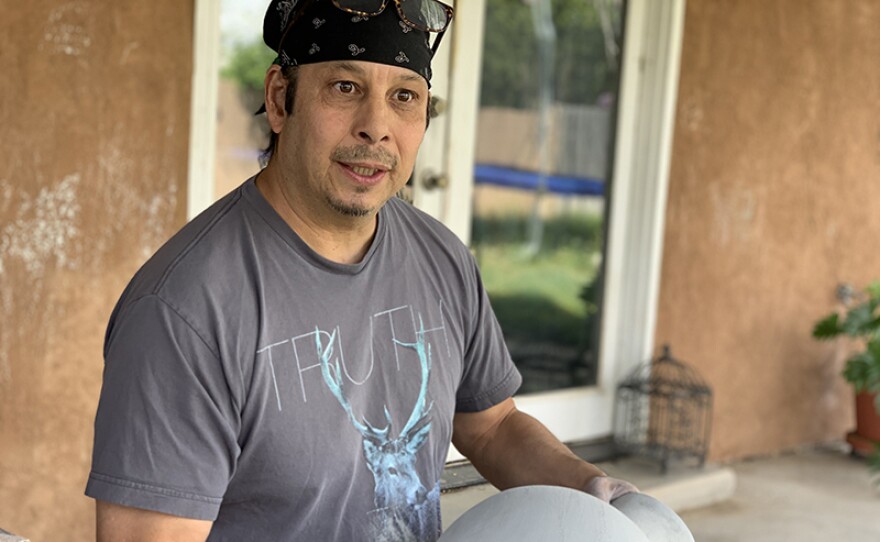Friday, June 9, 2023 at 9 p.m. on KPBS 2 / Stream now with the PBS App
How do we define ourselves, what combination of work, ethnicity, nationality, family and heritage, go into the sum of who we are? CRAFT IN AMERICA "Identity" explores how artists challenge accepted norms of gender, race, culture and place, offering truer expressions of their experience in this world.
Meet The Artists:
We are introduced to Diego Romero, a potter living and working in Santa Fe, New Mexico, a member of the Cochiti Pueblo tribe.
“I am an Indian. I am a white man, too. Am I this white kid who grew up in Berkeley or am I this Johnny-come-lately, back-to-the-village, born again Indian? I think I’m neither and I’m both,” says Diego Romero.
He makes art that transcends his Native American heritage by combining traditional materials, techniques and forms of ancient Mimbres, Anasazi and Greek pottery with comic book inspired imagery, to talk about contemporary issues.

Romero is a self-proclaimed “chronologist on the absurdity of human nature,” whose comic narratives venture into taboo areas of politics, environment, racism, alcoholism, love, life, and loss. His trademark Chongo Brothers characters connect his work to Pop Art, inviting the viewer to look at Native Indian pottery in a new way. His work is in the collection of the British Museum among other world-class museums, and he is married to photographer Cara Romero.

Contemporary photographer Cara Romero, a member of the Chemehuevi Indian Tribe of the Chemehuevi Reservation (a branch of the Southern Paiute) of the Mojave Desert, California, is outspoken on indigenous cultural and environmental issues.
“Growing up on the reservation rests at the heart of who you are as a human being, it informs everything that you are, going forward in life,” says Cara Romero.
Her complex and nuanced images combine traditional iconography with a contemporary perspective, bringing past, present and future into consideration.

The artist orchestrates a balancing act in her photography by rewriting stories of Indian identity, battling cultural misappropriation, and confronting stereotypes, particularly of Native women, all the while preserving tradition and maintaining cultural sensitivity.

Delving into matters of ethnicity, gender and world issues in her studio in San Diego, California, we meet Wendy Maruyama, furniture maker and educator. Born an American of Japanese heritage, Maruyama nurtures her artistic talent as a highly accomplished woodworker and furniture designer in a field dominated by men, and in the process, surmounts challenges related to her deafness and disability.
“I realized… my being deaf was probably the first identity that I consciously was aware of…. then of course, being Japanese American, and then there was the issue of being a female in a male dominated field, so it’s a pretty unique identity,” says Wendy Maruyama.

Wendy speaks passionately about her work, including a recent series titled wildLIFE Project, inspired by the wrongful slaughter of African elephants and rhinoceroses, and The Tag Project, a 2012 commemorative installation memorializing the forcible relocation of 120,000 ethnic Japanese to internment camps during World War II. Historian Delphine Hirasuna elaborates.
As a survival tactic, these American citizens, imprisoned in remote camps surrounded by barbed wire and machine gun wielding soldiers, turned to making art as a means of sustaining life, redefining themselves, and finding beauty in a place where others would never find it. It was their way to “gaman,” to bear the seemingly unbearable with patience and dignity.

We next travel to the green mountains of North Carolina where Cristina Córdova, sculptor, lives and works at Penland, far from her birthplace, Puerto Rico.
“Puerto Rican identity is at the core of everything that I depart from to understand the world,” says Cristina Córdova. Her deeply affecting figurative clay work is rooted in renaissance sculptural traditions.
Each piece represents a shared humanity while confronting contemporary issues of gender, race, beauty and power, and inviting the viewer’s participation.

Through the work of all the artists profiled, CRAFT IN AMERICA "Identity" explores how heritage and cultural identity contribute to the richness of America’s cultural landscape. The lives and work of the artists featured personify the diversity of this country and how each unique tradition magnifies and illuminates a shared American experience.
Watch On Your Schedule:
With the PBS App, stream your favorite PBS shows, create the perfect watchlist, connect with your local station, and more — anywhere you watch.
Join The Conversation:
CRAFT IN AMERICA is on Facebook, Instagram, @CraftinAmerica on Twitter





